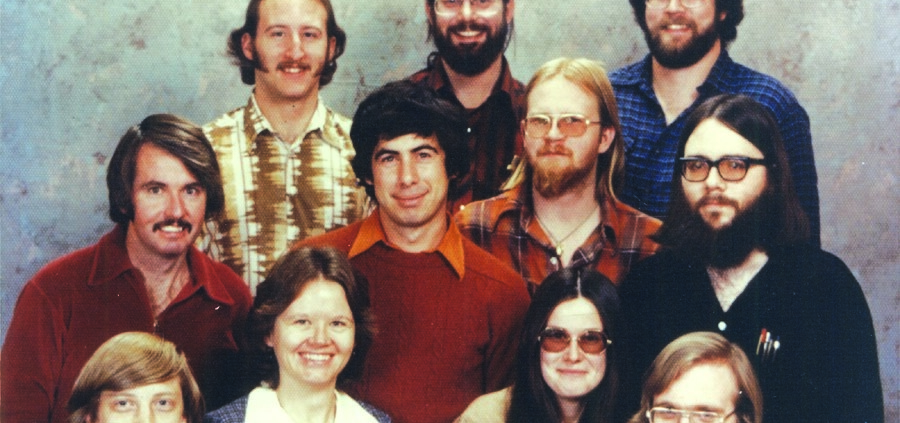The Bell-Bottom Billionaires
Take a trip with me back to 1979. You’re standing in line at a gas station, waiting your turn to purchase fuel at three times its cost from a few short months ago. The oil embargo, coupled with runaway inflation, is eating away at your paycheck. That home you were thinking of purchasing? Out of reach now, thanks to double-digit interest rates imposed by Paul Volcker at the Federal Reserve. Nixon is gone, the gold standard abandoned, and BusinessWeek just released a piece titled “The Death of Equities.”
Not the happiest of times.
You strike up a conversation with the guy from the next car, someone seemingly sensible beyond his years. Out of nowhere, he drops this bit of wisdom: “You know, someday just two companies will be worth as much as the entire U.S. economy right now.”
“Sure thing, buddy,” you say, spinning your finger next to your head to sign “crazy” to your spouse in the car. Anything is possible. But realistic? Yeah, right.
Yet … here we are.
In 1979, the inflation-adjusted GDP of the entire United States was $6.97 trillion. Today, the combined market capitalization of Microsoft and Apple alone is about $6.94 trillion. Combine Nvidia and Microsoft, and it’s $8.28 trillion. In other words, the total value of all goods and services produced by the United States in 1979 now equates to about 84% of the value of just two of its top companies.
Admittedly, this is sort of an apples to oranges comparison. GDP measures output, not value, like market cap. But that assessment, while fair, misses the point: progress via innovation. Innovation, especially in technology, is cumulative — and at times, exponential.
The 1970s were a mess. After Nixon left the gold standard in 1971, inflation surged. Real incomes fell as prices rose. The S&P 500 peaked in 1973, shortly before being cut in half. The Vietnam War, Watergate, and the Arab Oil Embargo all contributed to a turbulent geopolitical environment. Lines formed at gas stations. It was an era of malaise on many fronts.
But amid all this discontent, the microprocessor was born. Intel launched the first commercially available chip in 1971. In 1975, two young guys named Bill Gates and Paul Allen founded Microsoft. The following year, Steve Jobs and Steve Wozniak formed Apple in a garage. Nvidia came a little later in 1993, when its founder Jensen Huang created specialized graphics processors for PC gaming. Today, revenue from these three companies accounts for almost 2.5% of the U.S.’s entire economic output.
That’s a sizeable amount, but three companies do not an economy make. To further put this progress in perspective, remember that the S&P was at 108 in 1979. Today, it’s about 6,300, a 58-fold increase. That’s an 11.8% annual growth rate from the day equities died (according to BusinessWeek) to May of 2025. That means if you’d invested $10,000 in something tracking the S&P 500, you’d have about $1.6 million today, less taxes.
Headlines get attention, but they aren’t always right. Good ideas — those that power the next decade’s innovation — will work quietly behind the scenes, regardless of their press coverage. The media feeds on urgency, but investing and innovation take time and patience. As an equity owner, you can choose either fear or patience; historically, only one has been consistently profitable.
Those who waited patiently through the 1970s eventually saw the tide turn. The Volcker Fed broke rising inflation. America gained energy independence through innovations in shale and fracking. Vietnam became a key trading partner and producer. Equities rebounded, climbing higher than imaginable. Nearly all the fears blasted on the nightly news evaporated in the rearview mirror, only to be replaced by new end-of-the-world-causing events.
Being told in 1979 that two yet-to-be-founded companies would be worth more than the entire output of the U.S. economy would have sounded like science fiction. But this history offers a valuable reminder that the future is so big, it’s almost incomprehensible. Looking ahead, what could these numbers look like in 30, 40, even 50 years? Innovation doesn’t wait for good news, and as investors, we must focus on owning a piece of it.
No timeline is ever smooth, but progress is inevitable. On what will you choose to focus?
At its core, investing requires optimism and a belief in the ingenuity of mankind. Setbacks will happen, but progress inevitably delivers a brighter future. It’s possible, even probable, that our grandkids will compare today’s GDP to the value of a company being founded in someone’s garage today. Don’t let fear dissuade you from investing in it.
Steve Booren is the Owner and Founder of Prosperion Financial Advisors, located in Greenwood Village, Colo. He is the author of Blind Spots: The Mental Mistakes Investors Make and Intelligent Investing: Your Guide to a Growing Retirement Income and a regular columnist in The Denver Post. He was recently named a Barron’s Top Financial Advisor and recognized as a Forbes Top Wealth Advisor in Colorado.







